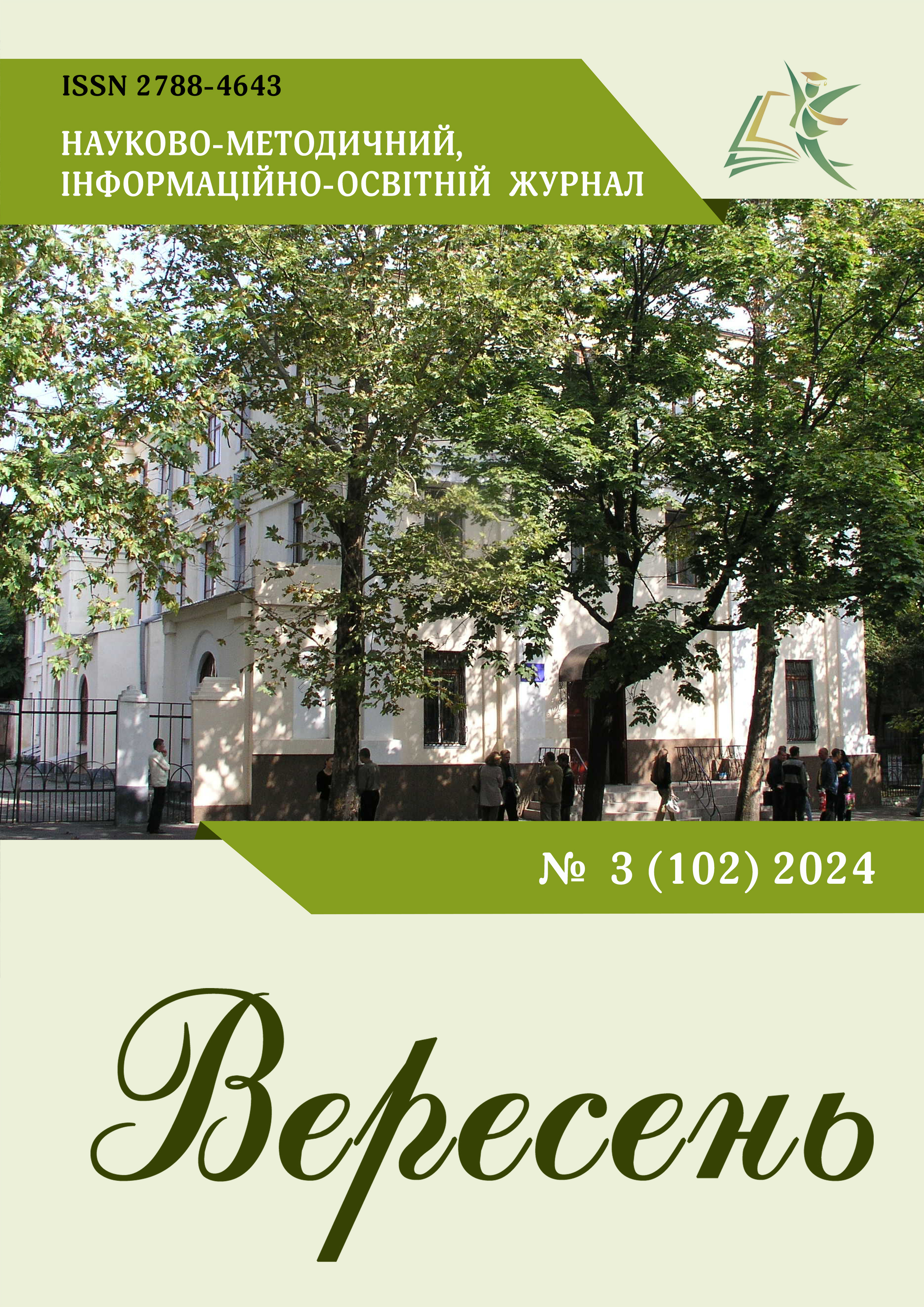THE FORMATION OF PUPILS’ COGNITIVE MOTIVATION VIA STEAM-EDUCATION INSTRUMENTS TEACHING GEOMETRY
DOI:
https://doi.org/10.54662/veresen.3.2024.05Keywords:
geometry, integration, epistemology, critical thinking, competence tasks, cross-cutting skills, synergy, STEAMAbstract
The article focuses on the importance of epistemological beliefs in the context of modern STEAM education. The role of these beliefs as an integral component of educational practice and how they shape the learning experience of students is emphasized in the paper. The interdisciplinary nature of STEAM and its application in teaching practice are described, emphasizing how such an approach can improve student engagement and understanding of complex subjects, particularly geometry. The article highlights the importance of facilitating the STEAM process of teachers, particularly the teachers of mathematics, who can prepare students to solve both creative tasks and life tasks. The role of educators is important in creating an environment where students can develop research skills in STEAM. The study addresses the concept of belonging to STEM fields, suggesting that intrinsic motivation, personal interest, and social determinants play a significant role in student engagement in STEAM subjects. The authors describe the benefits and strategies of integrating STEAM into school practice through projects, lessons, and creative spaces, too. These environments allow students to express their creativity, collaborate with peers, and bring their ideas to life. It is noted that many students find it difficult to imagine the practical meaning of geometry in everyday life, which affects their motivation. However, the study of geometry is the key to developing critical thinking and stimulating analytical, logical, and creative thinking. The article offers an example of the implementation of the STEAM approach during the study of geometry in the 10th grade on the topic «Coordinates and vectors. The equation of a circle». The approach involves integrating the subject of the lesson with STEAM disciplines, posing problematic questions, and selecting tasks that correspond to the age characteristics of the students. It was concluded that STEAM education has significant prospects, in particular, in promoting an interdisciplinary approach and solving educational problems, so further research is needed to study the practical aspects of developing students’ epistemological beliefs through STEAM education.
References
Andriievska, V. M, & Bilousova, L. I. Kontseptsiia BYOD yak instrument realizatsii STEAM-osvity [BYOD Concept As A Tool Of STEAM Education Implementation]. Fizyko-matematychna osvita, 4 (14), 13–17 (ukr).
Bibi, A., Saira Akhtar, & Sadaf Zamir Ahmed. (2024). Problem-Solving Based Learning in STEM Education: Role of Epistemological and Motivational Beliefs Along with Self-Regulated Learning Strategies. International. Journal of Academic Research for Humanities, 4 (2), 106–115 (eng).
Canney, N., & Bielefeldt, A. (2015). A framework for the development of social responsibility in engineers. International Journal of Engineering Education, 31(1), 414–424 (eng).
Сreativepark. Сanon. Retrieved from: creativepark.canon/ (eng).
CST-100 Starliner. Vikipediia/ Retrieved from:https://uk.wikipedia.org/wiki/CST-100_Starliner (ukr).
Dost, G. Students’ perspectives on the ‘STEM belonging’ concept at A-level, undergraduate, and postgraduate levels: an examination of gender and ethnicity in student descriptions. International Journal of STEM Education 11:12 (2024). DOI: https://doi.org/10.1186/s40594-024-00472-9 (eng).
Gunckel, K. L., & Tolbert, S. (2018). The imperative to move toward a dimension of care in engineering education. Journal of Research in Science Teaching, 55(7), 938–961. DOI: https://doi.org/10.1002/tea.21458 (eng).
Hess, J. L., Sprowl, J. E., Pan, R., Dyehouse, M., Wachter Morris, C. A., & Strobel, J. (2012). Empathy and caring as conceptualized inside and outside of engineering: Extensive literature review and faculty focus group analyses. American Society for Engineering Education (ASEE) Annual Conference (eng).
Huang, B., Jong, M.S.-Y., King, R. B., Chai, C.-S., & Jiang, M.Y.-C. (2022). Promoting secondary students’ twenty-first century skills and STEM career interests through a crossover program of STEM and community service education. Frontiers in Psychology. DOI: https://doi.org/10.3389/fpsyg.2022.903252 (eng).
Kerbal Space Program. URL: https://www.kerbalspaceprogram.com/ (eng).
Klymenko, L. O. (2016). Udoskonalennia navychok uchytelia-pryrodnychnyka z uprovadzhennia v navchalnyi protses metodiv piznannia pryrody (u mezhakh STEM-osvity) [Improving the skills of a naturalist teacher in the introduction of methods of learning about nature into the educational process (within STEM education)]. Molodyi vchenyi, 10(37), 44–248 (ukr).
Kriachko, I. (2013). Korotkyi putivnyk zorianym nebom. Astroosvita. Retrieved from: https://astroosvita.kiev.ua/infoteka/articles/Korotkii-putivnyk-zorianym-nebom-4.php (ukr).
Liskovych, O. (2023). Vykorystannia Mozhlyvostei STEM-osvity u protsesi pidvyshchennia kvalifikatsii vchyteliv fizyky ta astronomii [Using the opportunities of STEM education in the process of improving the qualifications of physics and astronomy teachers]. Veresen, 2(97), 40–49. DOI: https://doi.org/10.54662/veresen.2.2023.04 (ukr).
Makhrovska, N. A., Pohromska, H. S. & Kolesnyk, S. V. (2023). Tekhnolohichna karta yak instrument planuvannia diialnisnoho uroku [Technological map as a tool for planning an activity lesson]. Veresen, 3 (98), 22–32. DOI: https://doi.org/10.54662/veresen.3.2023.02 (ukr).
Metodychni rekomendatsii shchodo rozvytku STEM-osvity v zakladakh zahalnoi serednoi ta pozashkilnoi osvity u 2023/2024 navchalnomu rotsi. Retrieved from: https://osvita.ua/legislation/Ser_osv/89820/ (ukr)
Palii, A. A. (2010). Dyferentsialna psykholohiia [Differential psychology: Study guide]. Kyiv. Retrieved from: https://symboldrama.if.ua/wp-content/uploads/2020/03/a.a.-palij-dyfyrencziana-psyhologiya.pdf (ukr).
Planets / Terytoriia 12 [Planets / Territory 12]. Retrieved from: https://www.territory12.in.ua/schoolhtml/web/1/index.html (ukr).
Pohromska, H. S., Makhrovska, N. A., & Rohozhynska, E. K. (2022). Relevantnist matematychnoi osvity u synerhii skladovykh STEM [The relevance of mathematics education in the synergy of STEM components]. Veresen, 3(94), 17–28. DOI: https://doi.org/10.54662/veresen.3.2022.03 (ukr).
Roberts, T., Maiorca, C., Jackson, C., & Mohr-Schroeder, M. (2022). Integrated STEM as Problem-Solving Practices. Investigations in Mathematics Learning, 14(1), 1–13. DOI: https://doi.org/10.1080/19477503.2021.2024721 (eng).




